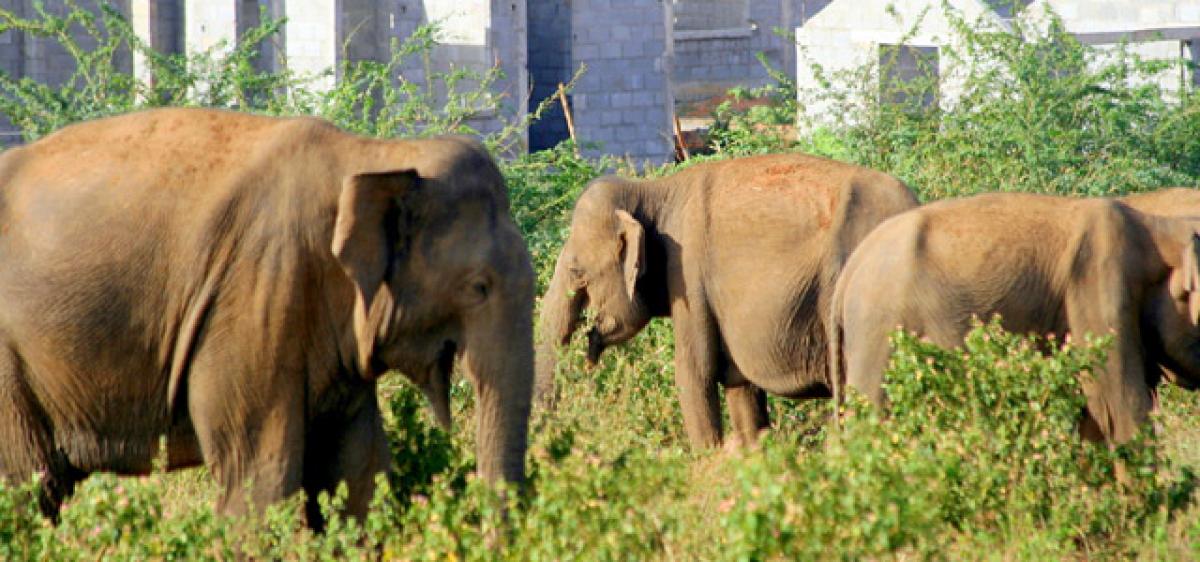Live
- Cyclone kills 14 in French territory Mayotte
- 3rd Test: Head, Smith centuries flatten India on Day 2
- AAP Announces Final Candidate List For 2025 Delhi Assembly Elections, Kejriwal To Contest From New Delhi
- Bangladesh unrest has delayed execution of some vital projects: Tripura CM
- PIL in SC seeks direction to designate BMC as sole planning, sanctioning authority for Mumbai
- 3rd Test: Centuries from Head, Smith help dominant Australia feast on listless India
- AAP final list of 38 names in Delhi: Kejriwal, CM Atishi retain seats
- Tributes Paid to Sardar Vallabhbhai Patel on His Death Anniversary at CM Revanth Reddy's Residence
- In just one year, Bhajanlal govt wins hearts of people
- CM Chandrababu announces establishment of Potti Sriramulu Telugu University
Just In

West Bengal has evolved a rather unique solution to growing human-elephant conflicts (HECs) constructing toilets so that villagers don\'t have to defecate in the open and face the wrath of the jumbos.
West Bengal has evolved a rather unique solution to growing human-elephant conflicts (HECs) constructing toilets so that villagers don't have to defecate in the open and face the wrath of the jumbos. This has now become a thrust area for Forest Department officials to tackle HECs, particularly in the southern part of the state, which is a hub for such aggression.
Although Bengal harbours only two percent of India's wild elephant population (around 30,000 jumbos in the country), they are believed to be responsible for over 20 percent of the total human deaths. Open defecation is one of the concerns flagged by officials in West Midnapore district, where accidental deaths do occur when villagers, who come to relieve themselves in the wee hours, find themselves face to face with pachyderms in the forests bordering their hamlets.
Range officers are generating awareness and pushing for construction of toilets under the state's Nirmal Bangla mission to transform all the hamlets to Open Defecation Free (ODF) villages by October 2, 2019. "We are working in a concerted manner so that the Nirmal Bangla Scheme is implemented involving Divisional Forest Officers (DFO) so that all villages close to forests have toilets," Chief Wildlife Warden and Principal Chief Conservator of Forests Pradeep Vyas told this correspondent.
The state government recently gave the green signal to create a new division in West Midnapore district in view of frequent elephant attacks. Bankura and West Midnapore account for the maximum number of HECs. In 2015-2016, 108 people were killed and 95 injured by wild elephants in the state. Fourteen elephants have been killed in retaliation.
In 2016, a rogue tusker was shot down in the forests of southern Bengal as a "last resort" as per a decision of the state government. Though there has been a "sizable decrease" in human deaths over the year, Vyas said integration of development initiatives with environment protection is necessary.
And toilets are part of the deal! "There are several deaths that happen early in the morning when people go out to the fringes of villages to defecate. Out of 18 human deaths (mostly accidental) in 2016 in West Midnapore, four or five can be attributed to open defecation. We are spreading the message among people to avoid this habit and at the same time pushing for toilet construction in all houses," Midnapore Divisional Forest Officer RN Saha said.
Toilet construction coverage is close to 60 percent in the district. "Among the 10.17 lakh households in the district, 4.12 lakh are yet to get access," pointed out Dibyendu Sarkar, Commissioner in the Panchayat and Rural Development Department. Compounding the issue is the nearly year-round stay of the jumbos, which arrive from neighbouring Jharkhand.
Elephants were abundant in the dense sal forests of the erstwhile Midnapore District as early as 1900. The population dwindled and became very small by mid-1980s due to loss of forest cover and depletion of food, a paper authored by forest official Subhamay Chanda says. From 1987 onwards, migratory herds from Dalma in what is now Jharkhand started coming to southern West Bengal on a regular basis, resulting in a steady rise in man-elephant conflicts in this region.
"They used to come in small numbers and gradually their numbers increased (30 at a time). Subsequently, their range also expanded. Currently, 130 elephants are roaming in this area. They stay in Bengal for most part the year and go back to Jharkhand only for about a month," Saha explained, dubbing them as "Bengal haathi".
This apart, the jumbos also have an affinity for a homemade brew called mahua (an alcoholic drink made from the sweet flower of the tropical mahua tree) and often ransack huts in search of the tipple. "We are providing extensive materials to villagers to ensure they do not disturb the animals and tips on how to stay protected against attacks. We have also started an SMS-based system alerting them of the animals' movements. There has been a decrease in the conflicts but we still have a long way to go," Saha added.
Advocating use of toilets, wildlife biologist Varun Goswami of the Wildlife Conservation Society (WCS), pointed out that elephants are generally scared of people and, left to themselves, would rather not encounter humans. "This is why they typically traverse through human-dominated areas, or engage in crop raiding, at night. When elephants are on edge, accidental encounters with people can lead to unintended elephant-caused human deaths. Such encounters are best avoided, and in this case, easily achieved through a small change in routine -- the use of toilets rather than open defecation," Goswami said.
By Sahana Ghosh

© 2024 Hyderabad Media House Limited/The Hans India. All rights reserved. Powered by hocalwire.com







